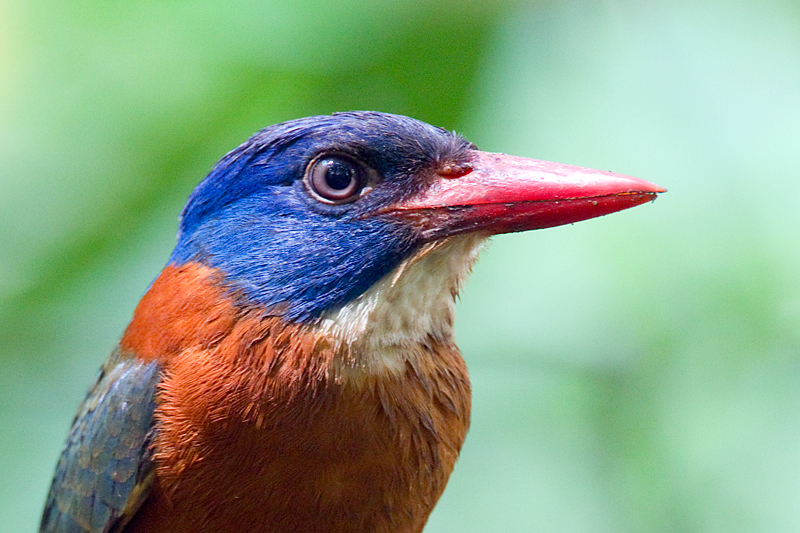
North Sulawesi – Trip Report – November 2012

I’d had the aim of visiting Indonesia and Sulawesi in particular for a while and I finally got the chance in November this year.
Unfortunately, time was limited so I spent the 3 full days based at the Tangkoko Batuangus Nature Reserve in Northern Sulawesi.
19th November 2012
I flew into Manado on SILKAIR and after all the formalities, I left the airport just after 2pm. The drive was largely uneventful but I did get the first of Sulawesi’s endemics – an overflying Knobbed Hornbill. I arrived at Batu Putih at around 4:30pm – the drive taking longer than normal due to the driver being uncertain of the route and taking a couple of wrong turns! It was too late to do any proper birding but I wandered down the first part of the road into the Reserve and picked up another of Sulawesi’s endemics – the Sulawesi Babbler.
Main birds seen: Grey Rumped Treeswift, Hair Crested Drongo
20th November 2012
I had arranged to meet Yann Muzika in Tangkoko – he arrived at around 1am so it was a bit of a struggle getting up at 5am for our first morning’s birding. Any sleepiness soon disappeared as we spotted a beautiful Red Backed Thrush as soon as we crossed the bridge into the reserve! This is often an elusive species so it was great to get a view so early in our trip (in fact it was the only time we got to see this bird but heard it calling on a couple of other occasions).
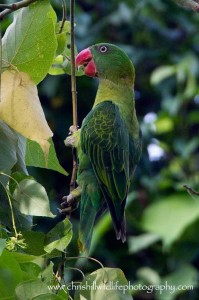
There were also a number of Sulawesi Babblers calling along the first part of the road but good views were difficult. We picked up the first of our Kingfishers where the road gets closer to the river just before the park entrance – not an endemic but a nice pair of Ruddy Kingfishers. Entering the reserve itself, we headed to the old campsite and got distant views of a pair of White Necked Mynas (E), Golden Mantled Racquet-tails, and a Black Naped Fruit Dove. A bit of bird activity led us into the forest and we got good views of a Yellow Billed Malkoha (E), Bay Coucal (E) and Blue Backed Parrots. The parrots were quite unconcerned about our presence and it became a game of constantly trying to get into position to get a clear shot.
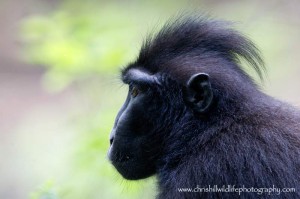 A troop of the endangered Crested Black Macaque (or Celebes Crested Macaque) then passed through, giving us our first look at this charismatic primate. One of the young was having great fun climbing a young sapling which slowly gave way when he neared the top, returning him to the ground – he did this a number of times, just like a child on a playground slide!
A troop of the endangered Crested Black Macaque (or Celebes Crested Macaque) then passed through, giving us our first look at this charismatic primate. One of the young was having great fun climbing a young sapling which slowly gave way when he neared the top, returning him to the ground – he did this a number of times, just like a child on a playground slide!
Moving along through the forest, the guides picked up on calling Lilac Cheeked Kingfisher and we got great views of both a male and female.
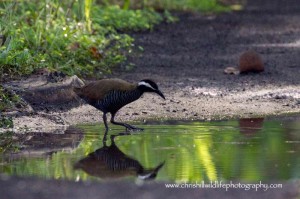
Further along the road, there is a small shelter before a more open patch of grassland on the left. Stopping there, a we tried for the Barred Rail which was calling close to the road. It showed briefly making a mad, comical dash across the road into cover on the other side. We thought that was likely to be it but a few minutes later, it sauntered out and stood in the middle of the road preening and feeding in a puddle, seemingly in an forlorn attempt to regain some dignity after it’s prior showing!
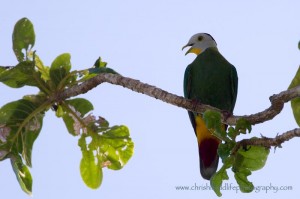
A decent sized flock of Grosbeak Starlings (E) then came in overhead, sharing the tree with another gaudy Black Naped Fruit Dove and Sooty Headed Bulbul.
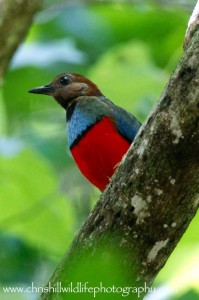
We came to the end of the road near the Research Station and headed in on one of the forest trails, where we soon glimpsed a distant figure bounding along the forest floor – a male Red Bellied Pitta. It continued to give us fleeting glimpses whilst it circled around before settling up a tree where it sat unconcerned calling for a good half an hour before we reluctantly left him. Further along the trail, we ticked off another of Sulawesi’s endemic kingfishers – the Green Backed. These large birds are very confiding and sit motionless for long periods of time allowing great views – often at head height or below.

Heading back, we bumped into the troop of macaques again before getting back to Mama Roos around 1pm. It was one of those mornings were the action was non stop – our only concern was whether we had brought enough memory cards!
Other birds seen: Blacknaped Monarch, Yellow Sided Flowerpecker (E – feeding in a fruiting tree at Mama Roos), Collared Kingfisher, White Rumped Cuckooshrike (E), Brown Throated Sunbird.
There was a heavy shower just as we got back to Mama Roos which continued until around 3:30pm.
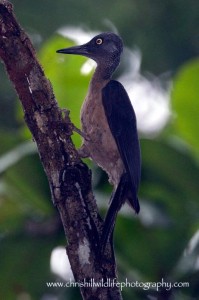
We headed back out at around 3:45pm and the afternoon understandably couldnt quite live up to the morning session. The main thing seen was a pair of Ashy Woodpeckers (E).
At dusk, we headed to one of the known roosts of the Spectral Tarsier. These adorable creatures spend the day roosting in tree hollows and if you are there at the right time, it’s possible to see these emerging at dusk ahead of their night time foraging.
We then headed deeper into the forest to a stakeout spot for the Minahassa Masked Owl, which we tried for for an hour in vain. Heading back to camp, we heard numerous Sulawesi Scops Owls but didn’t try for them.
21st November 2012
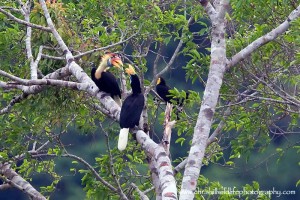
A slightly earlier start saw us up at 4:30 for a 5am departure up to the Hornbill Lookout. There was a great view over the forest below from the lookout but Samuel took us down a narrow path to a spot closer to the forest canopy. First sighting was a number of hornbills in a fruiting tree – a family of Knobbed Hornbills as well as 4-5 Sulawesi Dwarf hornbills. Continuing down the hill, we spent the next couple of hours in a great spot watching the morning ‘rush hour’ of canopy traffic – numerous species of dove, racquet-tails, hanging parrots and lorikeets.

Main birds seen: Golden Mantled Racquet-tail (E), Ornate Lorikeet (E), Purple Winged Roller (E), Silver Tipped Pigeon (E), Slender Billed Crow, Grey Sided Flowerpecker (E), Sulawesi Crested Myna (E), Yellow Breasted Racquet-tail (E), Large Sulawesi Hanging Parrot (E), Small Sulawesi Hanging Parrot (E), White Bellied Imperial Pigeon, Green Imperial Pigeon, Sulawesi Black Pigeon (E), Olive Backed Sunbird, Black Billed Koel, Uniform Swiftlet, White Bellied Glossy Swiftlet.
At about 9:15am, it was starting to warm up so we headed back up to the top of the ridge, spotting a soaring Sulawesi Hawk Eagle on the way, as well as three flying Sulawesi Crested Mynas.
The birding slowed down a bit with the rising temperatures but we picked up a Sulawesi Serpent Eagle before heading back at around 11am.
Main birds seen: Brahminy Kite, Black Fronted White-eye, Yellow Billed Malkoha, Lesser Coucal.

The usual lunchtime rain didn’t appear and we prayed for the good weather to continue as we headed down to the beach to get aboard an outrigger for a trip out to the nearby mangroves. Whilst waiting, we were able to watch a fishing White Bellied Sea-eagle and also added a couple of easy ticks to the list – Eurasian Hedge Sparrow and Pacific Swallows. The short sea crossing to the mangrove gave us a great view of a Lesser Frigate-bird and a flock of fishing Black-naped Terns.
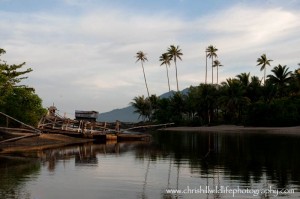 The main target of the mangrove trip was the Black Billed Kingfisher, but there were plenty of interesting ‘appetizers’ – Pacific Reef Heron, White Rumped Cuckooshrike, Common Sandpiper, Grey Tailed Tattler, Whimbrel, Little Heron, Pied Imperial Pigeon, Intermediate Heron, Common Kingfisher.
The main target of the mangrove trip was the Black Billed Kingfisher, but there were plenty of interesting ‘appetizers’ – Pacific Reef Heron, White Rumped Cuckooshrike, Common Sandpiper, Grey Tailed Tattler, Whimbrel, Little Heron, Pied Imperial Pigeon, Intermediate Heron, Common Kingfisher.
We had no luck heading into the mangrove but when nearly back at the mangrove mouth, the guide and I got a fleeting glimpse of a Black Billed Kingfisher which had been flushed by faster moving vessel heading up the channel towards us. It disappeared down a narrow channel and there was no chance of following it. Yann had been photographing a Wimbrel at the time and unfortunately missed it and my view had been pretty poor so I was certainly happy when Yann asked the boatman to go around again. It seemed like our chance had gone as we again saw no sign on the way out or back. 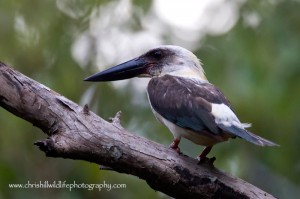 A small consolation was a number of Black Bitterns that started appearing along the channel. I imagine that most people miss them here as they only came visible as the light was falling – a consequence of our extended stay in the mangrove! When we were near the end again, the kingfisher flew overhead, back up the cannel – we all got a view but we quickly turned the boat to try and get a view off it perched. It had disappeared around a corner and cautiously crept around the bend, hoping to see it before it saw us and flew! Unbelievely, it was only about 10m away when we rounded the bend and it sat long enough to get a few photos. Needless to say, we were all very relieved and Yann’s “we are not leaving until I’ve seen it” attitude had paid off handsomely! Great stuff!
A small consolation was a number of Black Bitterns that started appearing along the channel. I imagine that most people miss them here as they only came visible as the light was falling – a consequence of our extended stay in the mangrove! When we were near the end again, the kingfisher flew overhead, back up the cannel – we all got a view but we quickly turned the boat to try and get a view off it perched. It had disappeared around a corner and cautiously crept around the bend, hoping to see it before it saw us and flew! Unbelievely, it was only about 10m away when we rounded the bend and it sat long enough to get a few photos. Needless to say, we were all very relieved and Yann’s “we are not leaving until I’ve seen it” attitude had paid off handsomely! Great stuff!
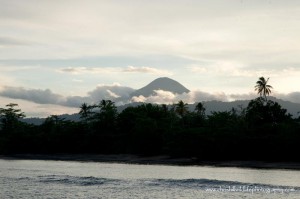 The journey back was a relaxed affair with another target seen and we had a lovely ride back enjoying the spectacular views.
The journey back was a relaxed affair with another target seen and we had a lovely ride back enjoying the spectacular views.
The boatman ended up dropping us off on a beach near the research station in the park to give us a night walk back to try for the Sulawesi nightjars and Scops owl. Just after heading off, our guide picked up on a high pitched call and found a pair of Spectral Tarsiers, right by the road – well away from their known roosting spots. 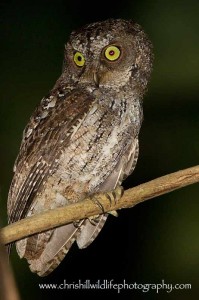 It was hard to get a clear view with all the foliage but we ended up getting some nice shots of them in their habitat. With the extended trip to the mangroves, it was too dark to stand a chance of seeing the Sulawesi Nightjars hawking over an open grassland area but we did hear them. Further up the road, we bumped into Samuel who was in the process of calling up a Sulawesi Scops owl for another couple of birders. After a while, we managed a couple of views – with the owl showing at one end of the road and then the other. It was all a bit ‘Keystone Cops’ with the group of us running in one direction and then the other but a good result in the end!
It was hard to get a clear view with all the foliage but we ended up getting some nice shots of them in their habitat. With the extended trip to the mangroves, it was too dark to stand a chance of seeing the Sulawesi Nightjars hawking over an open grassland area but we did hear them. Further up the road, we bumped into Samuel who was in the process of calling up a Sulawesi Scops owl for another couple of birders. After a while, we managed a couple of views – with the owl showing at one end of the road and then the other. It was all a bit ‘Keystone Cops’ with the group of us running in one direction and then the other but a good result in the end!
22nd November 2012
In our quest to see all the endemic kingfishers, we were up at 2am for a 2:30 departure to Mount Mahawu – one of only two places known for fairly reliable sightings of the Scaly Breasted Kingfisher (and by far the easiest to get to). The trip was fairly easy at that time in the morning, although we did hit rain and low cloud as we arrived at the site at 4:15am. As it was still dark, we had time for a kip in the car before heading down a steep path to the stakeout spot just after 5am. We didn’t have to wait long as a quick call had a kingfisher quickly approach us – unfortunately, not in the direction we were expecting and very close. We then had to frantically re-postion ourselves on a steep slippy hill, treading a fine line between not wanting to spook the bird and taking too long and missing the opportunity.

Fortunately, I managed to get off one record shot before it flew down the valley, not to show itself again. The most difficult endemic kingfisher in the bag and reward for our early start! An unexpected bonus was a fleeting glimpse of the hard to find Rufous Throated Flycatcher on the way back up. After a welcome picnic breakfast back at the car, we headed to the summit of the mountain before spending the next few hours birding the road back down.
Main birds seen: Citrine Flycatcher, Rufous Throated Flycatcher, Yellow Vented Whistler, Scarlet Honeyeater, Brown Cuckoo dove, Sulawesi Serpent Eagle, Black Faced Munia, Grey Wagtail, Mountain White-eye, Island Verditer Flycatcher, Crimson Crowned Flowerpecker, Yellow Sided Flowerpecker.
We left just after 10am and made it back at Mama Roos by 12:15. Unfortunately, the lunchtime showers started at 12:10….

The apparent price for yesterday’s rain free day was an extended downpour today with it only starting to ease after 3:30pm. It was still a bit wet and very gloomy when we headed out, determined to make the most of our last day and try for the last remaining endemic kingfisher – the Sulawesi Dwarf. The birding was relatively slow, at least compared to prior sessions but we did pick up an Emerald Dove and Isabelline Bush-hen. Heading onto the trails, we tried a known haunt of the Sulawesi Dwarf Kingfisher and quickly managed a fleeting view – giving us a full house of the endemic kingfishers!!
It was now too late to head back to try for the Sulawesi Nightjar so we decided to go to the ‘Tarsier Tree’ again. This proved to be a great decision as the rain had kept all the less dedicated visitors away and we were the only ones there. This allowed us plenty of opportunities to fill our memory cards with images of these bizarre creatures.
22nd November 2012
Yann unfortunately had an early flight and left at 5am. Two minutes after he departed, a Great Eared Nightjar did a couple of laps above Mama Roos, calling to wave him off.

My target for the morning was to try and improve on my various kingfisher shots, particularly the Sulawesi Dwarf seen briefly the day before. The morning started well with good views of the Lilac Cheeked and Green Backed Kingfishers. We also finally managed to spot the juvenile Sulawesi Hawk Eagle that had been consistently calling from the same area all week.
 The next couple of hours was spent looking for the Dwarf Kingfisher – despite all the effort, we didn’t hear a peep – the phrase ‘needle in a haystack’ sprung to mind. A nice consolation though was a Sulawesi Scops Owl roosting at eye level. It was tricky getting a clear shot with the right light but the owl was unconcerned by me slowly moving around – even starting to doze off at one stage! Unfortunately time had beaten us and we had to start heading back so I could leave to get my flight.
The next couple of hours was spent looking for the Dwarf Kingfisher – despite all the effort, we didn’t hear a peep – the phrase ‘needle in a haystack’ sprung to mind. A nice consolation though was a Sulawesi Scops Owl roosting at eye level. It was tricky getting a clear shot with the right light but the owl was unconcerned by me slowly moving around – even starting to doze off at one stage! Unfortunately time had beaten us and we had to start heading back so I could leave to get my flight.
Overall, it had been a very successful and enjoyable trip. We had seen around 86 species in the 3 full days of birding, including all the endemic kingfishers and had some great photographic opportunities along the way. I would certainly be keen to return to Sulawesi – to try Tangkoko again and also visit the highland regions. Highly recommended!
FURTHER INFORMATION: Tangkoko and the surrounding area

Hi Chris,
Looks like Tangkoko is a better place to visit for birding than Arfak. Great write up and really nice photos.
Regards
Ronnie
Hi Ronnie,
Thanks for your comments. I’ve not been able to bird West Papua yet but my impression is that Tangkoko is certainly more accessible for birdwatchers and easier to see the key species in a relatively short space of time. The species list for Arfak looks pretty mouth watering tho!
Regards,
Chris